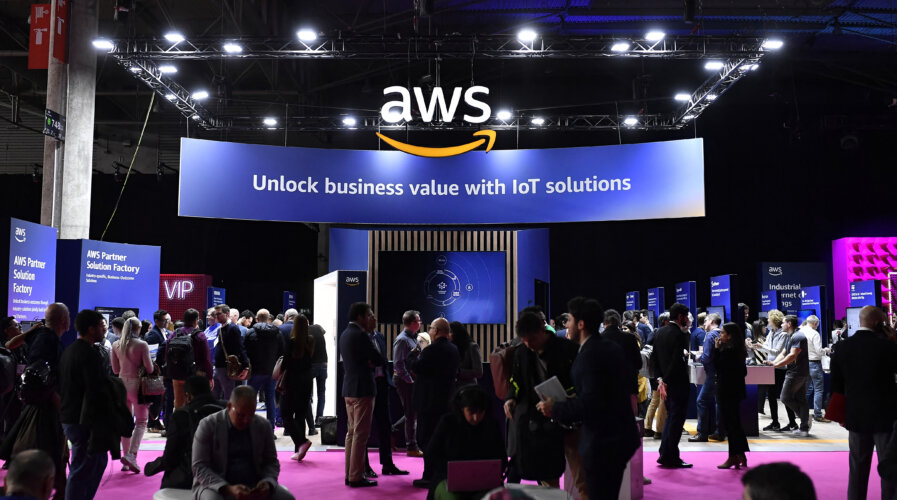
AWS wants to help you build generative AI tools. Here’s how(Photo by Pau BARRENA / AFP)
AWS wants to help you build generative AI tools
|
Getting your Trinity Audio player ready... |
- AWS announced several innovations that will make it easy and practical for its customers to use generative AI in their businesses.
- The new AWS cloud service, Amazon Bedrock, is designed to let enterprises select foundation models for building their own generative AI applications for targeted use cases and commercial use.
Artificial Intelligence (AI) and Machine Learning (ML) have been a focus for Amazon for over two decades, and it’s a timely move; the tech giant announced that its cloud arm, Amazon Web Services (AWS), is dipping its toes into the generative AI space. As such, AWS unveiled four innovations across its ML portfolio to make generative AI more accessible to customers essentially.
“At AWS, we have played a key role in democratizing ML and making it accessible to anyone who wants to use it, including more than 100,000 customers of all sizes and industries,” VP of database, analytics, and machine learning services at AWS, Swami Sivasubramanian said in a blog post. Considering that, Swami said the cloud giant would be taking the same democratizing approach to generative AI.
“We work to take these technologies out of the realm of research and experiments and extend their availability far beyond a handful of startups and large, well-funded tech companies. That’s why today I’m excited to announce several innovations that will make it easy and practical for our customers to use generative AI in their businesses,” he added.
Generative AI can create new content and ideas, including conversations, stories, images, videos, and music. Like all AI, generative AI is powered by ML models—huge models pre-trained on vast amounts of data and commonly referred to as Foundation Models (FMs).
AWS makes it easy to build and scale generative AI applications with FMs
The first new tool AWS unveiled is Amazon Bedrock, a new service that makes Foundation Models (FMs) from AI21 Labs, Anthropic, Stability AI, and Amazon accessible via an API. Swami reckons Bedrock is the easiest way for businesses to build and scale generative AI-based applications using FMs, democratizing access for all builders.
“Bedrock will offer the ability to access a range of powerful FMs for text and images—including Amazon’s Titan FMs, which consist of two new large language models (LLMs) announced with Amazon Bedrock,” he noted. In short, Amazon has also created its FMs, dubbed Titan, and the announcement commemorates its first pair of models.
Titan Text is a generative LLM used to summarize text, create text such as blog posts, classify, open-ended Q&A, and extract information. Titan Embeddings translates text inputs (words, phrases, or possibly large units of text) into numerical representations (known as embeddings) containing the text’s semantic meaning.
It can be used to improve search results and personalization. To better understand the concept of generative AI and FMs, let’s backtrack. Recent advancements in ML–specifically the invention of the transformer-based neural network architecture–have led to the rise of models that contain billions of parameters or variables.
To give a sense of the change in scale, Swami shared that the largest pre-trained model in 2019 was 330M parameters. Now, the most significant models are more than 500B parameters—a 1,600x increase in size in just a few years. Today’s FMs, such as the LLMs GPT3.5 or BLOOM, and the text-to-image model Stable Diffusion from Stability AI, can perform various tasks.
“FMs can perform so many more tasks because they contain many parameters that make them capable of learning complex concepts. And through their pre-training exposure to internet-scale data in various forms and myriad patterns, FMs learn to apply their knowledge within various contexts,” Swami highlighted.
Customized FMs, on the other hand, can create a unique customer experience, embodying the company’s voice, style, and services across various consumer industries. This is why the potential of FMs is fascinating, although, as Swami puts it, we are still in the very early days.
“We expect new architectures to arise in the future, and this diversity of FMs will set off a wave of innovation. We already see new application experiences never seen before,” he added. AWS also unveiled tools–Amazon EC2 Trn1n instances powered by AWS Trainium and Amazon EC2 Inf2 instances powered by AWS Inferentia2–enabling companies to build, customize, and use FMs more efficiently and economically.
Swami explained that Trn1n instances double the network bandwidth compared to its Trn1 instances and are designed to deliver 20% higher performance for large, network-intense models over Trn1 instances, which, it said, can on their own deliver up to 50% savings on training costs compared to other EC2 instances.
Amazon EC2 Inf2 instances, powered by AWS Inferentia2 chips, offer the highest performance, most energy efficiency, and the lowest cost for running generative AI inference workloads at scale on AWS. “Inf2 instances deliver up to 4x higher throughput and up to 10x lower latency compared to the prior generation Inferentia-based instances,” Swami wrote, adding that it can drive up to 40% better inference price performance than any other EC2 instance.
The last bit of application unveiled by AWS was Amazon CodeWhisperer, a generative AI tool to assist developers in writing better code more quickly. AWS said it is accessible to individual developers, and it uses an FM under the hood to improve developer productivity by generating code suggestions in real-time, based on developers’ comments in natural language and prior code, in their preferred Integrated Development Environment (IDE), via the AWS Toolkit IDE extensions.
CodeWhisperer has been in preview since last year. “During the preview, we ran a productivity challenge. Participants who used CodeWhisperer completed tasks 57% faster, on average, and were 27% more likely to complete them successfully than those who didn’t use CodeWhisperer,” Swami said. “This is a giant leap forward in developer productivity, and we believe this is only the beginning.”
Meanwhile, in a shareholder letter by Andy Jassy, AWS CEO, the company wants to democratize technologies so companies of all sizes can leverage Generative AI.
“AWS is offering the most price-performant machine learning chips in Trainium and Inferentia so small and large companies can afford to train and run their LLMs in production. We enable companies to choose from various LLMs and build applications with all of the AWS security, privacy and other features that customers are accustomed to using. And, we’re delivering applications like AWS’s CodeWhisperer, which revolutionizes developer productivity by generating code suggestions in real time. I could write an entire letter on LLMs and Generative AI as I think they will be that transformative, but I’ll leave that for a future letter. Let’s just say that LLMs and Generative AI are going to be a big deal for customers, our shareholders, and Amazon,” stated Jassy.
READ MORE
- Safer Automation: How Sophic and Firmus Succeeded in Malaysia with MDEC’s Support
- Privilege granted, not gained: Intelligent authorization for enhanced infrastructure productivity
- Low-Code produces the Proof-of-Possibilities
- New Wearables Enable Staff to Work Faster and Safer
- Experts weigh in on Oracle’s departure from adland


